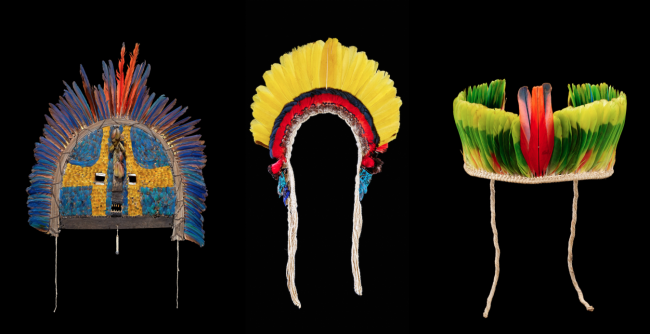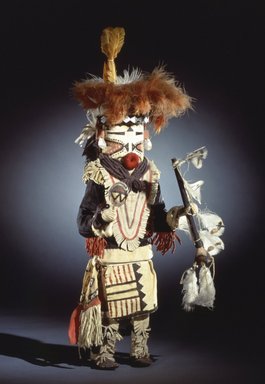Recently, I played tourist and went to the Point-à-Callière Museum in Old Montreal to see the exhibit on Amazonia: The Shaman and the Mind of the Forest. I am always drawn to exhibits about South America and spent almost a year in Brazil in the late 1970s. In fact, I landed in Manaus and travelled by boat for four serene days along the Amazon River as it snaked its way to Belem.  I say serene because the scenery hardly changed, continuous river with dense green jungle on both sides.
I say serene because the scenery hardly changed, continuous river with dense green jungle on both sides.
 Below is the late 19th century Manaus opera house, built with the wealth generated by the rubber barons. It closed with the crash in the early 20th century, but reopened in 1997 and now has its own philharmonic symphony.
Below is the late 19th century Manaus opera house, built with the wealth generated by the rubber barons. It closed with the crash in the early 20th century, but reopened in 1997 and now has its own philharmonic symphony.
Since my first visit, I have travelled extensively in Latin America and feel a deep, mysterious affinity for it, so I was excited about seeing the Amazonia exhibition.
On the first floor of the exhibit, many exquisitely beautiful artifacts were on display. Pictured below are a mask and two diadems made from bird feathers.

The photo is from the museum’s website.
The artistry of some of the huge earthenware pots was also impressive. I am reminded of a comment made by a colleague years ago. I was at a conference in Rome, one of the great cultural centres of the western world, and she asked me if I was going anywhere else that summer. When I replied that I was going to visit a friend in New Mexico, she laughed at the contrast, saying there was no history there. Now that’s a good example of western hegemony at work because there are many traces of ancient history in the Southwest. Below is a photo of the ancient cliff dwellings in the Canyon de Chelly in the Navajo Nation.

There are also a distinct cultures.  At the recent Chagall exhibit at the Montreal Museum of Fine Arts there was a Zuni Katchina doll on display to show the diverse sources that Chagall drew upon for inspiration for the modern ballet costumes he designed.
At the recent Chagall exhibit at the Montreal Museum of Fine Arts there was a Zuni Katchina doll on display to show the diverse sources that Chagall drew upon for inspiration for the modern ballet costumes he designed.
Just this past winter I read the fascinating The Lost City of Z, written by David Grann, who also writes for The New Yorker. The book was recently adapted into a film and marketed as an Indiana Jones type adventure story, but it is based on an actual explorer, Perry Fawcett, who was convinced there was an ancient civilization buried within the Amazon rainforest. Well, in the twenty-first century he has finally been proven correct. Wikipedia, in their article, note that the pottery methods used by the ancient tribes are nearly identical to those used today.
However, what drew me to the Amazonia exhibition was the emphasis on Shamanism, which has always fascinated me. I think the subtitle of the exhibition expresses the capacity of the shaman well. Through rituals and the ingestion of mind-altering natural substances, the shaman becomes one with the forest. It is a merging of consciousness. In a special issue of the magazine Tribal Art, Boris Wastiau, the Director of the Musée d’ethnographie de Genève, explains that the forest is “a conscious ecosystem from which [the shamans] are ontologically inseparable.” For those who have never felt the essential presence or consciousness of the natural world, this may seem strange, yet it is our alienation from the natural world that is leading to our demise. This is a tragedy that could be avoided.

The Amazonia exhibit also had much to say about the precarious state of the rainforest. Oil spills by companies such as Exxon and Chevron have devastated parts of the region. Gold diggers, who use mercury to extract the gold, are poisoning the rivers. Logging is also a major problem. On 25 August, Amy Goodman of Democracy Now! reported that the Brazilian president, Michel Temer, is
abolishing a vast reserve of tropical rain forest in what conservationists are calling the biggest attack on the Amazon of the last 50 years, the move ending protections for the Renca Reserve, a swath of rainforest the size of Denmark, paving the way for road building, mining, and logging.
Indigenous tribes in the Amazon are fighting to preserve the Amazon rainforest, not only for their own survival, but for the survival of the planet. In terms of its size and biodiversity, the Amazon rainforest if the largest in the world. It is vital to our survival as it supplies 20% of the world’s oxygen.
While I wrote this, Hurricane Harvey hit Texas. Hopefully more people will wake up to the reality of climate change and what is at stake.
